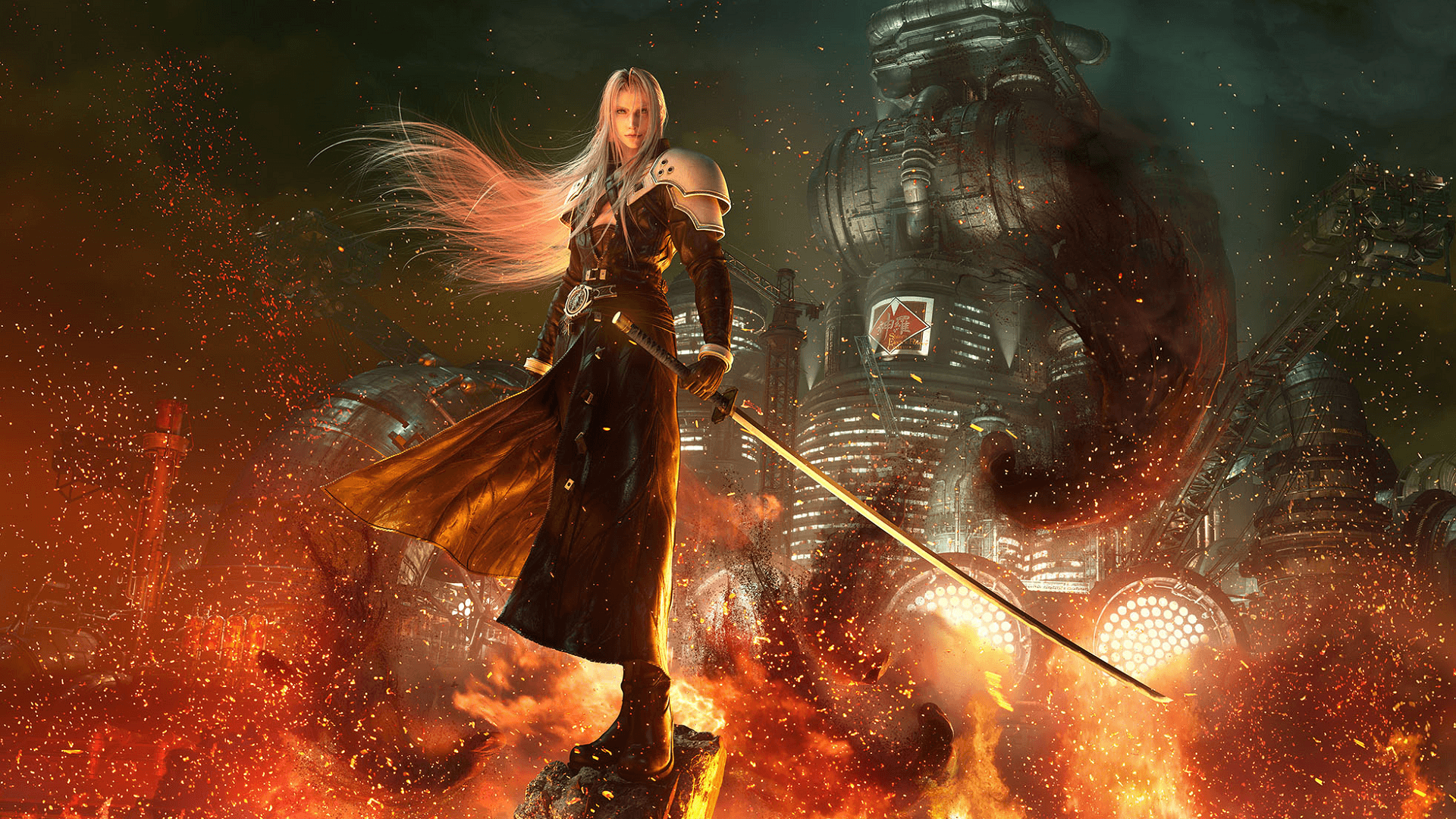Humanizing Sephiroth
How the FFVII Remake can continue to flesh out the infamous one-winged angel with one scene

Let me tell you about the first time I met Sephiroth. He’s a sleek character on the PlayStation screen, cooly holding his blade, HP a whopping 3264. With an effortless gesture, the dragon standing before him is obliterated. The victory music cues up and there I am besides him, cheesing it with my 140 HP. Sephiroth was everything the rumors and fanfare said he would be throughout the world of Gaia. He’s powerful, collected, and every bit impressive.
The game already established Sephiroth is my present-day foe, but I’m thankful this flashback has us on the same side. As much as I’m in awe of his power, all I can think about is the amount of grinding I’ll have to endure to even get close.
The mission we’re on together is simple: see what’s causing issue in the Nibel reactor, fix it, and go home. It’s fairly uneventful until Sephiroth peeks into one of the many pods in the reactor. He has to pull himself up to peek into its bluish window. Something stares back at him from within: a monstrous fusion of mako and human.

He’s disgusted, criticizing Hojo, hypothesizing what the Shinra scientist was attempting to accomplish. Here lies a ‘monster.’ Sephiroth calmly explains the role of mako in becoming a SOLDIER, offhandedly mentioning how the process for him differed from normal recruits —
He pauses.
He shakes, cradling his head, a dangerous thought rattling through his head. He snaps. He’s moving across the room, slashing at the pods, wondering out loud if he’s any different. Is he, also, a monster?
He’s confused, questioning that specialness he once took pride in. Is he nothing more than a successful monster?
No one is calming him down. There is no one with the courage to stop him from tearing the room apart. From tearing his own worth apart. There are only pods of twisted monsters and myself to bear witness.

Moments of powerful characters fraying on screen are magic to me. I’m fascinated by the vulnerability and what the audience and other characters are to make of it. The original Final Fantasy VII tried to choreograph Sephiroth’s existential crisis, with the limitations of 3D graphics and text.
It’s a scene that is often overlooked in Sephiroth’s story. When we reflect on Sephiroth’s story today, we often see Nibelheim in flames, Mother, let’s take the Planet back together, Aerith’s interrupted prayer, and Sephiroth and Cloud battling it out. What remains poignant in his story is that loss of self we see in Sephiroth — both mentally and physically.
But one aspect of his story that deserves more attention is Sephiroth’s humanity. The Sephiroth that believed himself to be a hero and not the “perfect monster.” The Sephiroth who broke apart on screen.
While the 2007 Crisis Core began the journey of humanizing and fleshing out Sephiroth, the FF7 Remake holds the potential for fully realizing it.

The Odd SOLDIER Out
Crisis Core gives players a unique look at the SOLDIER program and the inner workings of Shinra prior to the Final Fantasy VII storyline. While the game is ultimately Zack’s story, in the backdrop we see a human Sephiroth that we only saw snippets of in the original.
While Sephiroth continues to emulate the cool and collected hero that Cloud will recount in his memories, Sephiroth is quietly vulnerable in Crisis Core. We see that vulnerability through his relationships with two fellow SOLDIER colleagues: Genesis and Angeal.
While Sephiroth identifies the two of them as friends and his actions will be influenced by his relationship with them, he’s the odd man out.
It’s the curse of the three friends group: it can work, but there are two friends who hold a stronger bond with each other. Here, Angeal and Genesis share a closer bond with each other and it’s one the game cruelly reminds Sephiroth and players.
Despite these reminders given by the game, even when Angeal and Genesis have both deserted Shinra without saying a word to him, he still holds the two of them dear to him.
“I understand now why Sephiroth chose you. Genesis and Angeal. Those two were Sephiroth’s only friends. He didn’t want to fight them. That’s why he refused the mission.”
Crisis Core establishes that Sephiroth struggles to communicate and lacks confidence in his own relationship with his two friends. It’s why Zack is heavily relied upon by him.
He’ll flex his authority and outright refuse missions that involve him pursuing either of them. He’ll retell an old sparring story between them that led to Genesis’ injury and trail off into silence, letting flashbacks of himself trying to help Genesis heal speak for him. He in no way wants to be the one to issue out the killing blow to either Genesis or Angeal. Zack, however, has what he lacks: the ability to earnestly communicate and, if needed, to end them both. Which in no way makes Sephiroth a great friend himself.
As Sephiroth later hears of Angeal’s death, he shares with Zack that he’s considering leaving Shinra. It feels like a man running away from his problems. He doesn’t have the stomach to face the eventual death of Genesis and the truth that he maybe never quite knew his friends to begin with.
Scrapping Sephiroth’s Breakdown
Crisis Core begins to follow events that we are closely familiar with near the tail end of the game. Moving through the reactor feels ominous in a way the original couldn’t quite realize. Sephiroth moves in front of JENOVA’s chambers like a man moving through the motions, thoughts preoccupied elsewhere.
Zack is the one who takes notice of the name on the chamber and instantly draws a connection. It’s too strange of a coincidence, but he keeps it to himself. He warily keeps an eye on Sephiroth. The discovery scene from the original FF7 begins to play out before us with fleshed-out graphics and voice acting.
“You said “average” member. What about you?”
When the realization comes, we’re given the chance to see that horrifying crumble. He’s staggering, cradling his head, pushing Zack aside — he’s interrupted. Genesis enters the scene, chiming in to confirm he’s a monster.

The emotional punch that comes with the scene is lost. Sephiroth manages to regain his composure and stand his ground against Genesis. The direction of the dialogue becomes one more focused on Genesis trying to recruit Sephiroth on his side and Shinra’s experimentation. We never get to see Sephiroth vulnerable again, even in the snapshots of him pouring through the Shinra Manor library. The scene started with a bang and ended on a whimper.
It’s Part of Sephiroth’s Story
Sephiroth is extremely good at surrendering to the demands of how characters in-game and even pop culture expect from him. He continues to show up and alternates between composed or chillingly antagonistic in later renditions of him.
In Crisis Core, Sephiroth’s breakdown was sidelined. Often the public response to breakdowns is to immediately excise it from the scene, which felt like what happened in Crisis Core. That uncomfortable moment we witness is what makes Sephiroth’s story a tragic one. Here he is both needing help and trying to come to terms with how he perceives himself.
The haphazard change he undergoes after locking himself in the Shinra Manor is devastating. Unable to come to terms with this truth, he adopts this false narrative that he is of worth, not because he’s a successful lab experiment, but because he’s aligned with Jenova. He is no longer able to independently see value in himself.
The idea of being able to witness this with today’s graphics, body capture, and voice acting would take this gut-wrenching scene to an entirely different level. Hearing the cool reverb of Sephiroth’s VA start to waver would be disturbing and jarring to experience, especially with those expectations we have in how Sephiroth is presented.
In a recent interview with Producer Yoshinori Kitase, he shared how they introduced Sephiroth early in the game, unlike the original, due to most players already knowing of him. In the original, Sephiroth was equivalent to the shark in Jaws: spoken of, but not seen. Now, it’s difficult to build suspense around his character because of his infamy.
However, said infamy and expectations could make this very scene shocking. Sephiroth’s breakdown never achieved an iconic status compared to other scenes he’s featured in. Producer Kitase could still have their Jaws moment, but as an existential crisis. Both are equally terrifying!
This also presents developers an opportunity to clarify the murky areas in Sephiroth’s story. Not only would revisiting this scene give us a more meaningful look into Sephiroth’s fall from grace, it can shed light on his relationship with Jenova. Issues with English translations in the original game have led to Jenova’s influence on Sephiroth’s descent into madness vague.
What made Sephiroth an interesting character when he was first introduced was his story and how his story shaped his character. Since then, Sephiroth has stepped outside the digital borders of Final Fantasy VII, his feud with Cloud known decades after the game’s climatic ending in 1997. The Remake has the power to reimagine this famous villain’s most vulnerable moment in their story arc and remind us he’s more than an iconic theme song.
